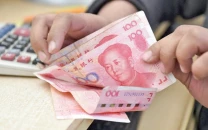Lagging behind in FDI race
Flexible labour markets, less regulatory burden, better infrastructure will attract investors

vVarious bodies keep talking about the same old things to boost the investment level in the economy. But it seems it either falls on deaf ears or there is simply the lack of commitment at the government level to take drastic steps. Or even there is a chance of the lack of capacity to take the necessary measures.
Some of the countries took off from a stage much behind Pakistan and now have skyrocketed way beyond us. What do they have that we don’t? There are some important questions that the government should seriously think about.
Are we trying to fit others model on Pakistan’s economy without tweaking it to fit the country’s needs?
The Indian automobile sector is the largest tractor manufacturer, second largest bus manufacturer and third largest heavy truck manufacturer in the world. Currently valued at $75 billion, the Indian auto industry is expected to touch the coveted $300 billion mark by 2026.
Foreign direct investment (FDI) equity inflow into India increased 19% to $59.64 billion during FY21. Computer software and hardware was the top sector with around 44% of the total FDI equity inflow, followed by construction and infrastructure-related activities at 13% and services sector at 8%.
Key factors behind the high FDI are low wage rates, skilled human resources, abundance of natural resources, political stability, independent judicial system and liberal policies.
FDI in computer software and hardware increased also due to the government’s incentive plan for the production of mobile phones, components and IT hardware.
Till 2006, the FDI in Vietnam hovered around $2 billion. Then it showed a sudden jump to $9.5 billion in 2007-08 (World Bank) and has since continued to grow.
Efficiency gains and consumer demand have been identified as key components of Vietnam’s investment attractiveness. Currently, the FDI is $16.1 billion, with the leading sectors being manufacturing and real state.
It is interesting to note that the FDI sector accounted for 72% of the total export turnover (63% of import turnover). This shows the FDI preference for trade-intensive sectors such as manufacturing and crude oil. Numerous trade agreements signed recently, including the EU-Vietnam free trade agreement and the UK-Vietnam free trade agreement, have made Vietnam attractive, especially for Japan and China, along with long-term stabilisation of interest rate.
Some other changes, similar to Pakistan, involve a daily adjusted rate, providing tax breaks for specific sectors, reducing corporate tax and providing a number of support packages for both foreign and local businesses.
Another country which raced ahead of Pakistan was Cambodia. In 2003, it had a mere $0.08 billion FDI, but as of 2019 its FDI was $3.7 billion. Much of this investment was in the manufacturing and real estate sectors.
It has a higher level of GDP growth, which has stayed above 6.5% (except for two years) after 1998.
Indonesian FDI was $1.9 billion in 2004, after staying negative for almost five years. It then continued to grow, especially after 2009, and reached $25 billion in 2019.
Its GDP growth has stayed in the band of 4-6% over the last two decades. Some key steps it took were acceleration of infrastructure and power sector development, introduction of a three-hour investment licensing service to complement the One Stop Service, efficiency in the national logistics cost, and no screening of imported capital goods, thus cutting the processing time from three to five days to only 30 minutes. Political stability has been a plus.
A similar but not consistent growth spurt was seen in Bangladesh after 2010. In 2009, the FDI was $0.9 billion and by 2019 it became $3.9 billion. Bangladesh’s incentives include special corporate tax rates, interest rates, personal income tax brackets, tax holidays, zones, etc.
Pakistan’s case
In Pakistan, there are several issues. These include functioning of labour markets, regulatory burden and infrastructure quality.
Labour market flexibility is important in determining the FDI as poor labour market indicators (such as the most person-days lost due to strikes) adversely impact the FDI inflow.
Contract enforcement is slow, problematic and tedious. PIDE’s latest report “Reform Agenda” estimates the number of days lost in various documentations, eg dealing with construction permits alone results in a loss of 237 days per firm.
A high risk of corruption (Pakistan has not signed the OECD Anti-Corruption Convention), low fiscal resources with poor prospects for development due to the continuing importance of informal economy and poor image of the country are important issues.
A weak intellectual property rights (IPR) regime and a lack of competent judges to deal with IPR litigation add to this. It is needless to say that high inflation rates and the persistent balance of payments deficit are major deterrents to the FDI.
The government should improve the policy for transparency and adopting international practices, and reform the administrative procedures. It should invest heavily in infrastructure (both physical and digital), giving priority to water supply and drainage, environment, sanitation, road, and seaport systems.
The country needs to focus not just on investment that serves the local market, but also on export-based investment. It should develop a public-private model to promote the capital market to allow deeper coverage, more sophisticated/tailoured products, and enhance the ability to raise funding.
Resources should be spent on enhancement of the quality of labour. Besides improving law and order and political stability, there is a need to understand that no solutions can be successful without investing aggressively in human capital.
The writer is a PhD scholar at IBA, Karachi
Published in The Express Tribune, June 21st, 2021.
Like Business on Facebook, follow @TribuneBiz on Twitter to stay informed and join in the conversation.



















COMMENTS
Comments are moderated and generally will be posted if they are on-topic and not abusive.
For more information, please see our Comments FAQ